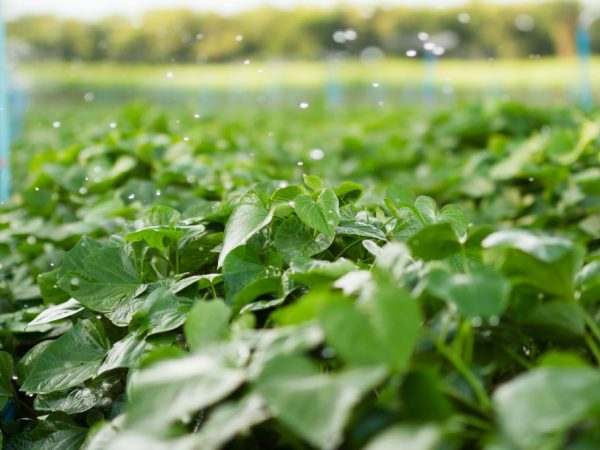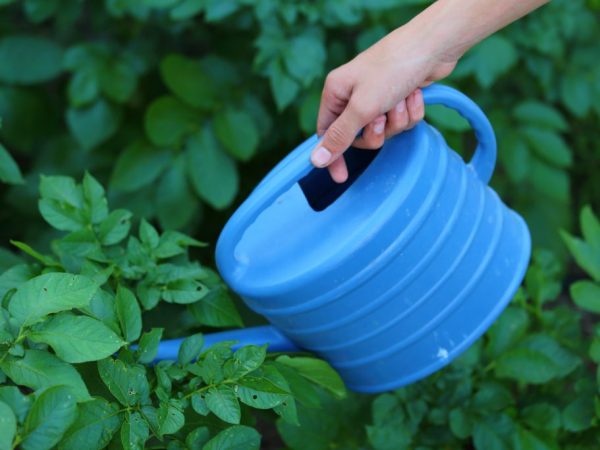Top dressing of potatoes in spring and summer
To get a good harvest of potatoes, fertilizers are applied to the soil. Consider how potatoes are fed and the best way to fertilize this vegetable crop.

Top dressing of potatoes in spring and summer
Fertilizers
A variety of fertilizers are used to feed potatoes. Some of them are introduced into the ground, some are sprayed on the aerial part of the plant. Depending on the method of application, top dressing is divided into root and foliar. The latter is also called "leaf dressing of potatoes". When growing this vegetable crop, the preparations are introduced into the ground.
After fertilizing the soil, the plant uses the root system to draw out all the necessary nutrients from the soil.
At the same time, you should not refuse to treat the bush with preparations containing trace elements useful for potatoes. Agronomists recommend using the following foliar dressings for potatoes:
- boron-manganese;
- nitrogen;
- phosphoric.
You can also feed the vegetable crop with microelements, which are not enough in the soil. Before applying top dressing for potatoes, study the composition of the soil. Mineral fertilizers should not be abused: an overabundance of any trace element negatively affects the yield of a vegetable crop.
Foliar dressing
Let's consider each of the recommended foliar dressing for potatoes separately.
Nitrogen
Fertilizing potatoes with urea (urea) is justified if the vegetable grows on sandy or any other light soils. Be sure to use a concentrated solution. When preparing the solution, make sure that the powder is completely dissolved in water, otherwise you can burn the plants.
The plant is sprayed in the evening while the sun goes down. The plant is healed with nitrogen-containing preparations in the first month of summer. If you process the plant in July, the tops will begin to actively develop. The plant will have no strength left for the development of tubers.
Summer feeding of potatoes with nitrogen-containing preparations prevents the appearance of nematodes.
Boron-manganese
Processing with a boric-manganese mixture is carried out as soon as the plant has bloomed. Both elements are important for this vegetable crop. Boric acid not only helps to increase yields, but also has a positive effect on the keeping quality of tubers.
Manganese has a positive effect on the taste of the product and increases its sugar content.
After the plant has bloomed and the tubers have formed, it is not necessary to use a preparation consisting of boric acid and manganese: it will have practically no effect on the vegetable crop.
Phosphoric

Phosphorus improves the taste of tubers
Phosphorus feeding of potatoes is carried out in the summer. Superphosphates must be added 30-35 days before the ripening of the vegetable, therefore it is difficult to indicate the exact dates: it all depends on the cultivated variety.
Phosphoric dressing has a positive effect on the taste of tubers and increases the storage period. In addition, phosphorus treatment increases the starchiness of the tubers. To dilute 10 g of superphosphates, take 10 liters of water.
Important points
You need to know not only how to feed the potatoes, but also how to do it correctly. Treatment of plant tops with special preparations in late spring or summer does not always give the desired result. If the vegetable crop suffers from a lack of basic elements, foliar processing will not improve the situation in any way.
The use of several fertilizers does not always have a beneficial effect on plants. For example, if plants are treated with urea and herbicides at the same time period, they will only suffer. Each product has instructions that describe which substances the drug is combined with poorly. They must be followed.
When deciding which fertilizers to feed the potatoes, take into account the characteristics of the soil. Urea is suitable for all types of soil.
Through young shoots, substances are absorbed faster, but these fragile shoots are the most sensitive, therefore, overly concentrated solutions will lead to burns.
Root fertilization
Root feeding of potatoes is done in spring and summer. There are 2 types of root dressing: surface and subsoil. Intrasoil top dressing works more efficiently, which involves the introduction of nutrient solutions into the soil layer where the root system of the potato is located. The surface method is that fertilizers are scattered on the surface of the soil.
It is most convenient to apply fertilizers to the ground in the "under stake" method. A recess 20-25 cm high is made in the ground (1 recess for 3 bushes). It is placed at the same distance from each bush. The nutrient mixture is poured into this depression. If you make a depression too close to the roots, the plant is likely to get burned.
Organic fertilizers
The best organic fertilizer for potatoes is chicken manure. It is rich in potassium, nitrogen and phosphorus, which are the most important trace elements for this vegetable crop. Chicken droppings are prepared in advance. 1 part of dry granules is poured into the container, 2 parts of water are added. Leave the mixture for 48-72 hours. The resulting organic fertilizer is diluted with water before use. For 1 part of the solution, give 10 parts of water.
Feeding potatoes with chicken droppings is carried out before hilling the potatoes. If necessary, you can feed the plants during the bud formation period. Mullein acts as an alternative to chicken droppings, but the vegetable reacts worse to it.
When growing a vegetable crop, potassium humate is used. This is a preparation obtained from humic acid salts. They are sometimes classified as growth promoters. The plant should be revitalized with humate only after the fourth leaf appears on the stem. The package with the drug contains instructions for its use. As a rule, 10 liters of water are taken for 2 g of powder. The drug is introduced into the soil at the rate of 3 liters per 1 hundred square meters. It is also used as foliar feeding.

Top dressing saturates plants with minerals
In the spring, manure is introduced into the soil. It is used both in pure form and as part of preparations. You should not use manure on soils saturated with various diseases: it will only provoke their development.
Mineral fertilizers
Effectively affects the yield and fertilizing potatoes with mineral fertilizers. Since the plant needs nitrogen, carbamide is introduced into the ground 1.5-2 weeks before planting the tubers. Granules can be scattered over the surface of the soil, water the area. If the site is not irrigated, the granules are sprinkled with earth.
The second time, urea is introduced during planting. In addition to urea, preparations containing potassium are introduced into the soil. Mineral fertilizers are sprinkled with earth, after which the planting material is laid.
In addition to urea, when planting, double superphosphate, ammonium nitrate, and ash are introduced into the ground. The first 2 drugs are applied at the rate of 1 kg per hundred square meters. Ashes are added 5 times more.
With some mineral fertilizers, the plant is fed several times per season. This mainly concerns nitrogen-containing preparations.
In the spring and before hilling, the potatoes are fed with ammonium nitrate. This fertilizer contains nitrogen. In podzolic soils, ammonium nitrate acidifies the soil, but on chernozems and neutral soils, ammonium nitrate can be used without fear of harming the vegetable crop.
During the formation of buds, it is advisable to feed the plants with nitroammophos. It increases the yield of vegetable crops. Fertilizing the plant with nitroammophos, you must strictly follow the instructions. The plant is also fed with potassium monophosphate.
Growth stimulants
There are drugs on sale that stimulate the growth of vegetable crops. Baikal EM-1 is popular.
Folk remedies
Vegetable culture is also fed with folk remedies that you can cook yourself. A variety of herbal infusions help to increase the yield, for the preparation of which even weeds can be used.
The green mass is placed in any container and filled with water. The infusion is left to ferment. Before use, the concentrated preparation is diluted with water. When diluting, they are guided by the color of the preparation: it should resemble weakly brewed tea. The resulting preparation is applied at the root. If the "under the stake" method is not used, make sure that the mixture does not get on the leaves and tops of the plant.
Another effective infusion is made from nettle. It is prepared in the same way as herbal: the stalks and leaves of the nettle are soaked, diluted with water before use.
Among summer residents, bait with yeast is also popular. The most common use involves diluting the yeast in water. Use "live" yeast. For 500 g of yeast, take 2.5 liters of water. The solution is left for 5-6 hours. Before use, dilute the resulting mixture with water (1 part of the mixture and 10 parts of water). It is allowed to use dry yeast, but in this case 5 g of yeast is taken for 5 liters of water. Before use, the drug is diluted with water in a ratio of 1: 5. The solution is applied to the ground in the spring.
When using preparations prepared on the basis of yeast, preparations containing potassium are additionally introduced into the soil. Yeast draws a large amount of this mineral from the soil, and the vegetable needs potassium for normal growth.
Conclusion
To increase the yield, a schedule for the introduction of drugs is made. Here, not only the names of funds are important, but also the timing of their introduction. In general, each summer resident decides for himself what kind of fertilizer to feed the potatoes. In autumn, the soil is enriched with mineral elements. It is best to use manure at this time.
In the fall, it is permissible to add humus, but over the winter it will turn into manure.
It is advisable to choose a tool that is cheaper. In the fall, superphosphate is introduced into the soil. After harvesting, it is advisable to plant green manures in the field. Siderata can be effectively used not only in autumn, but also in spring.

